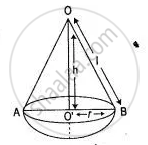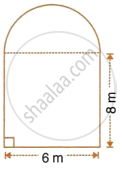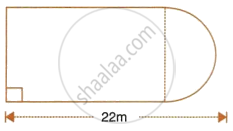Advertisements
Advertisements
Question
A buoy is made in the form of a hemisphere surmounted by a right circular cone whose circular base coincides with the plane surface of the hemisphere. The radius of the base of the cone is 3.5 m and its volume is two-third the volume of hemisphere. Calculate the height of the cone and the surface area of the buoy, correct to two decimal places.
Solution 1
Radius of hemispherical part (r) = 3.5 m = `7/2`m
Therefore, Volume of hemisphere = `2/3pir^3`
= `2/3 xx 22/7 xx 7/2 xx 7/2 xx 7/2`
= `539/6`m3
Volume of conical part = `2/3 xx 539/6` m3 (2/3 of hemisphere)
Let height of the cone = h
Then ,
`1/3pir^2h = (2 xx 539)/(3 xx 6)`
⇒ `1/3 xx 22/7 xx 7/2 xx 7/2 xx h = (2 xx 539)/(3 xx 6)`
⇒ `h = (539 xx 2 xx 2 xx 7 xx 3)/(3 xx 6 xx 22 xx 7 xx 7)`
⇒ h = `14/3`m = 4`2/3`m = 4.67 m
Height of the cone = 4.67 m
Surface area of buoy = `2pir^2 + pirl`
But `l = sqrt(r^2 + h^2)`
`l = sqrt((7/2)^2 + (14/3)^2)`
= `sqrt(49/4 + 196/9) = sqrt(1225/36) = 35/6`m
Therefore , surface area =
= `(2 xx 22/7 xx 7/2 xx 7/2) + (22/7 xx 7/2 xx 35/6)`m2
= `77/1 + 385/6 = 847/6`
= 141.17 m2
Solution 2
According to question.
`2/3` (Volume of hemisphere) = Volume of Cone
`2/3 ( 2/3 πr^3 ) = 1/3 πr^2h`
`4/9 (3.5)^3 = 1/3 (3.5)^2.h`
h = `(4 xx 3.5 xx 3.5 xx 3.5 xx 3)/(3.5 xx 3.5 xx 9)`
= `42.0/9 = 14/3 "m" = 4.67 "m"`
l = `sqrt (r^2 + h^2)`
= `sqrt((3.5)^2 + (4.67)^2)`
= `35/6` m
Now surface area of buoy = Surface area of right cone + Surface area of hemisphere
= πrl + 2πr2
= πr (l + 2r )

= `22/7 xx 3.5 (35/6 + 2 xx 3.5 )`
= 11 x (5.83 + 7)
= 11 x 12.83
= 141.13 sq.m.
APPEARS IN
RELATED QUESTIONS
Find the curved surface area of a cone with base radius 5.25 cm and slant height 10cm.
The area of the curved surface of a cone is 60 cm2. If the slant height of the cone be 8 cm, find the radius of the base?
The radius and slant height of a cone are In the ratio of 4 : 7. If its curved surface area is 792 cm2, find its radius. (Use it 𝜋 = 22/7).
A Joker’s cap is in the form of a right circular cone of base radius 7 cm and height 24 cm. Find the area of the sheet required to make 10 such caps.
There are two cones. The curved surface area of one is twice that of the other. The slant height of the later is twice that of the former. Find the ratio of their radii.
What length of tarpaulin 3 m wide will be required to make a conical tent of height 8 m and base radius 6 m? Assume that the extra length of material will be required for stitching margins and wastage in cutting is approximately 20 cm (Use it 𝜋 = 3.14)
Find the volume of a right circular cone with:
height 21 cm and slant height 28 cm.
Two cones have their heights in the ratio 1 : 3 and the radii of their bases in the ratio 3 : 1. Find the ratio of their volumes.
The ratio of volumes of two cones is 4 : 5 and the ratio of the radii of their bases is 2:3. Find the ratio of their vertical heights.
The total surface area of a right circular cone of slant height 13 cm is 90π cm2.
Calculate:
- its radius in cm.
- its volume in cm3. [Take π = 3.14].
A buoy is made in the form of hemisphere surmounted by a right cone whose circular base coincides with the plane surface of hemisphere. The radius of the base of the cone is 3.5 metres and its volume is two-third of the hemisphere. Calculate the height of the cone and the surface area of the buoy, correct to two places of decimal.
From a rectangular solid of metal 42 cm by 30 cm by 20 cm, a conical cavity of diameter 14 cm and depth 24 cm is drilled out. Find :
- the surface area of remaining solid,
- the volume of remaining solid,
- the weight of the material drilled out if it weighs 7 gm per cm3.
The cross-section of a railway tunnel is a rectangle 6 m broad and 8 m high surmounted by a semi-circle as shown in the figure. The tunnel is 35 m long. Find the cost of plastering the internal surface of the tunnel (excluding the floor) at the rate of Rs. 2.25 per m2.

In the following diagram a rectangular platform with a semi-circular end on one side is 22 metres long from one end to the other end. If the length of the half circumference is 11 metres, find the cost of constructing the platform, 1.5 metres high at the rate of Rs. 4 per cubic metres.

A solid, consisting of a right circular cone standing one a hemisphere, is placed upright in a right circular cylinder, full of water, and touches the bottom. Find the volume of water left in the cylinder, having given that the radius of the cylinder is 3 cm and its height is 6 cm; the radius of
the hemisphere is 2 cm and the height of cone is 4 cm. Give your answer to the nearest cubic centimeter.
Curved surface area of a cone is 251.2 cm2 and radius of its base is 8 cm. Find its slant height and perpendicular height. (π = 3.14)
A vessel in the form of an inverted cone is filled with water to the brim: Its height is 20 cm and the diameter is 16.8 cm. Two equal solid cones are dropped in it so that they are fully submerged. As a result, one-third of the water in the original cone overflows. What is the volume of each of the solid cones submerged?
A metallic cylinder has a radius of 3 cm and a height of 5 cm. It is made of metal A. To reduce its weight, a conical hole is drilled in the cylinder, as shown and it is completely filled with a lighter metal B. The conical hole has a radius of `3/2` cm and its depth is `8/9` cm. Calculate the ratio of the volume of the metal A to the volume of metal B in the solid.
A cloth having an area of 165 m2 is shaped into the form of a conical tent of radius 5 m. How many students can sit in the tent if a student, on an average, occupies `5/7` m2 on the ground?
